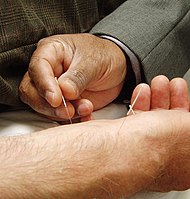
Photo from wikipedia
Background Hyposalivation is associated with the nutritional status. Anorexia of ageing, defined as an age-related decrease in appetite and food intake, presents even in healthy adults and is considered an… Click to show full abstract
Background Hyposalivation is associated with the nutritional status. Anorexia of ageing, defined as an age-related decrease in appetite and food intake, presents even in healthy adults and is considered an independent predictor of malnutrition, frailty, and mortality. However, the relationship between anorexia and hyposalivation of ageing is unclear. Thus, the present longitudinal study aimed to investigate the incidence of hyposalivation and its relationship with anorexia in community-dwelling older people in Japan. Methods The study population comprised 220 individuals (80 men and 140 women) aged 65–86 years at baseline. The participants underwent comprehensive health check-ups, including dental examinations and anthropometry, and face-to-face interviews in 2013 and 2019. Hyposalivation was determined on the basis of the unstimulated salivary flow rate measured using the modified cotton roll method. Anorexia was defined as a score of ≤29 in the Japanese version of the Council on Nutrition Appetite Questionnaire. Logistic regression analyses were used to test whether the presence of anorexia at baseline was an independent predictor of hyposalivation. Results Hyposalivation developed at a rate of 19.5% during the 6-year observation period. Anorexia was observed in 95 (43.2%) participants at baseline. After adjusting for potential confounding factors, anorexia (adjusted odds ratio [AOR], 2.65; 95% confidence interval [CI], 1.26–5.57) and polypharmacy (AOR, 3.29; CI, 1.06–10.19) were significant predictors of hyposalivation. Conclusion Loss of appetite is independently correlated with and a risk factor for hyposalivation in older adults. Anorexia of ageing may have negative effects on the salivary flow rate in such settings. Salivation should be a standard feature in clinical assessments of the older adults.
Journal Title: BMC Geriatrics
Year Published: 2020
Link to full text (if available)
Share on Social Media: Sign Up to like & get
recommendations!